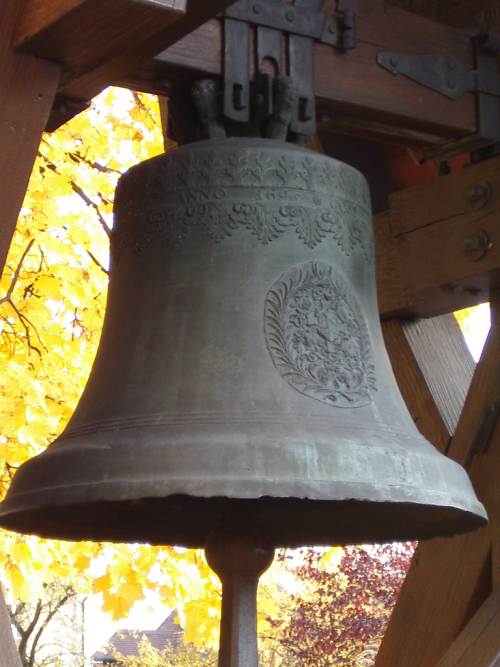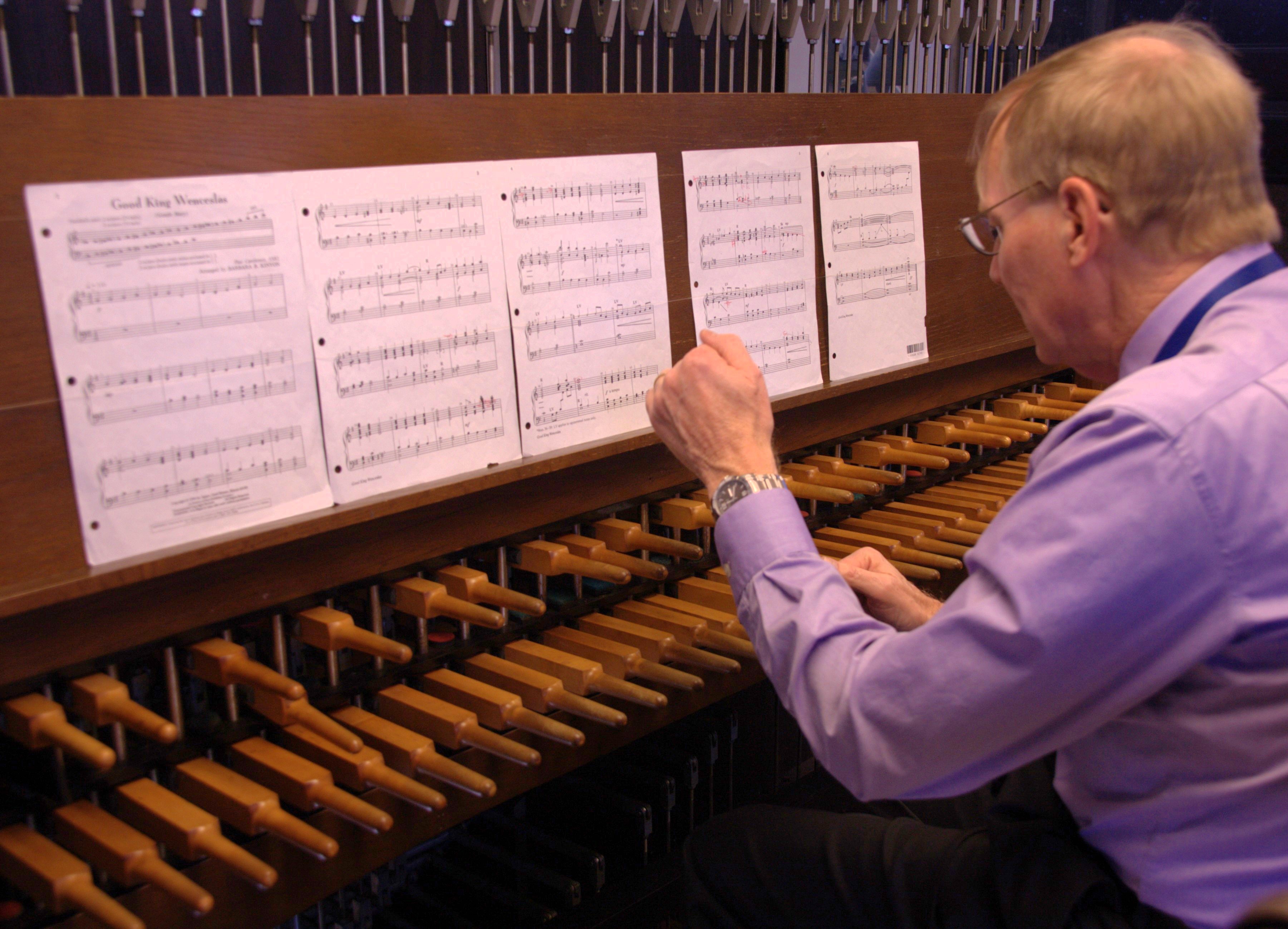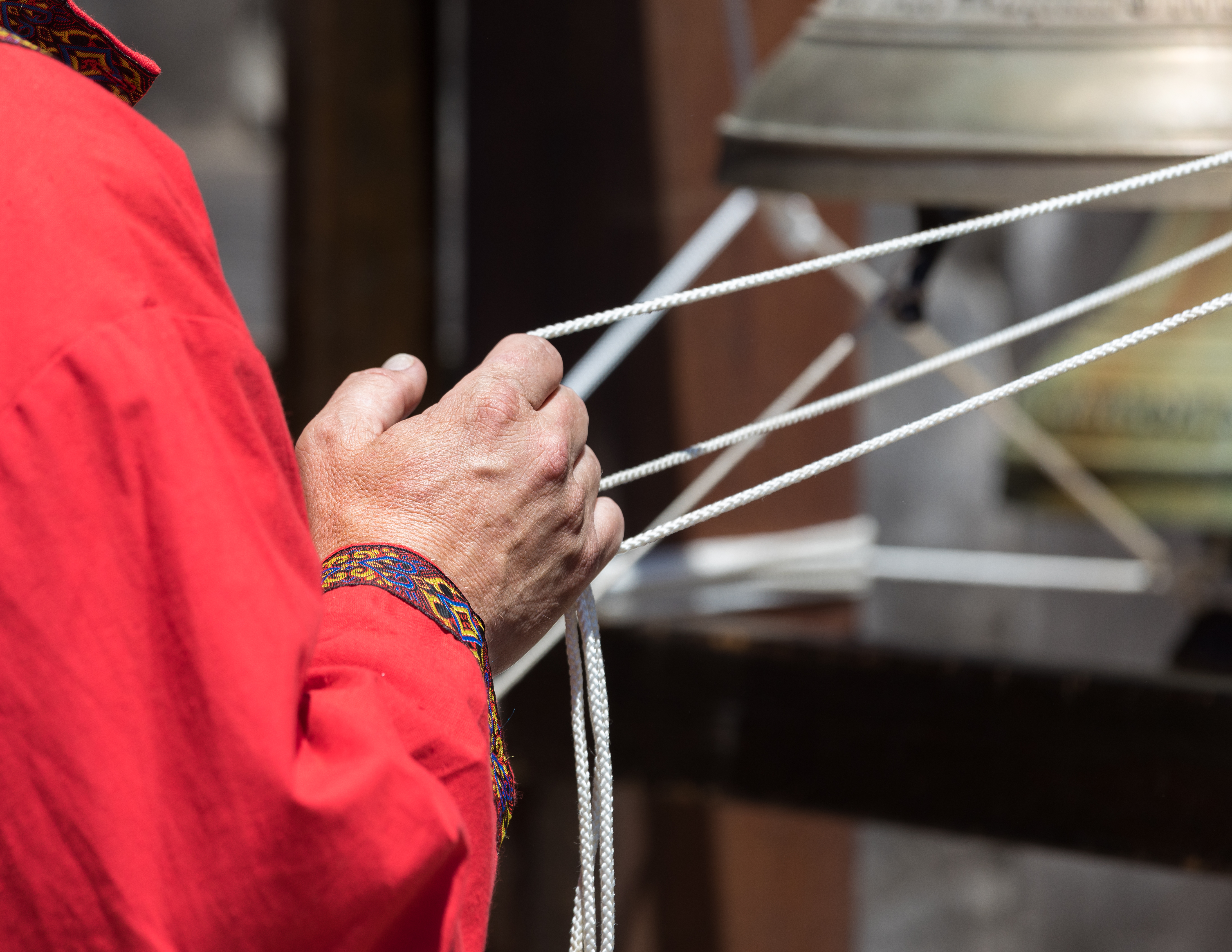|
Campanology
Campanology (/kæmpəˈnɒlədʒi/) is both the scientific and artistic study of bells, encompassing their design, tuning, and the methods by which they are rung. It delves into the technology behind bell casting and tuning, as well as the rich history, traditions, and techniques of bellringing as an art form. This field often involves the study of large, tuned bell collections, such as Flemish carillons, Russian Russian Orthodox bell ringing, zvons, or English "rings of bells" used for change ringing. These unique assemblages come with distinct practices and challenges, and campanology also explores the composition and performance of music written specifically for them. While campanology primarily refers to larger bells typically housed in towers, it is not usually applied to smaller bell collections, such as glockenspiels, tubular bells, or Indonesian gamelans. Instead, the term is most commonly associated with the use of large bells, their musical and historical significance, ... [...More Info...] [...Related Items...] OR: [Wikipedia] [Google] [Baidu] |
Carillon
A carillon ( , ) is a pitched percussion instrument that is played with a musical keyboard, keyboard and consists of at least 23 bells. The bells are Bellfounding, cast in Bell metal, bronze, hung in fixed suspension, and Musical tuning, tuned in Chromatic scale, chromatic order so that they can be sounded harmoniously together. They are struck with clappers connected to a keyboard of wooden batons played with the hands and Pedal keyboard, pedals played with the feet. Often housed in bell towers, carillons are usually owned by churches, universities, or municipalities. They can include an automatic system through which the time is announced and simple tunes are played throughout the day. Carillons come in many designs, weights, sizes, and sounds. They are among the world's heaviest instruments, and the heaviest carillon weighs over . Most weigh between . To be considered a carillon, a minimum of 23 bells are needed; otherwise, it is called a chime (bell instrument), chime. S ... [...More Info...] [...Related Items...] OR: [Wikipedia] [Google] [Baidu] |
Russian Orthodox Bell Ringing
Russian Orthodox bell ringing has a history starting from the baptism of Rus in 988 and plays an important role in the traditions of the Russian Orthodox Church. Theology The ringing of bells is one of the most essential elements of an Orthodox church. Church bells are rung to: *Summon the faithful to services *Express the triumphal joy of the Christian Church *Announce important moments during the services both to those in church and to those who are not able to be physically present in the church, so that all may be united in prayer *Strengthen Christians in piety and faith by its sound, which Orthodox Christians believe is "alloyed with divine grace to disperse and destroy the forces of cruelty and of demonic suggestion" (English translation 2003 by Blagovest Bells, San Anselmo, Cal.) *Proclaim important events, such as the death of a member of the church; the arrival of an important person, such as the bishop or civil ruler; an emergency such as fire or flood; or victory ... [...More Info...] [...Related Items...] OR: [Wikipedia] [Google] [Baidu] |
Hybrid Word
A hybrid word or hybridism is a word that etymologically derives from at least two languages. Such words are a type of macaronic language. Common hybrids The most common form of hybrid word in English combines Latin and Greek parts. Since many prefixes and suffixes in English are of Latin or Greek etymology, it is straightforward to add a prefix or suffix from one language to an English word that comes from a different language, thus creating a hybrid word. Hybridisms were formerly often considered to be barbarisms., ''s.v.'' 'barbarism' English examples * Antacid – from Greek () 'against' and Latin acidus 'acid'; this term dates back to 1732. * Aquaphobia – from Latin 'water' and Greek () 'fear'; this term is distinguished from the non-hybrid word '' hydrophobia'', a historical term for rabies and one of its main symptoms. * Asexual – from Greek prefix 'without' and the Latin ' sex' * Automobile – a wheeled passenger vehicle, from Greek () 'self' and Lat ... [...More Info...] [...Related Items...] OR: [Wikipedia] [Google] [Baidu] |
Bell-ringer Yaroslavl 2012
A bell-ringer is a person who rings a bell, usually a church bell, by means of a rope or other mechanism. Despite some automation of bells for random swinging, there are still many active bell-ringers in the world, particularly those with an advanced ringing tradition such as full-circle or Russian ringing, which are artistic and skilled performances difficult to automate. The term ''campanologist'' is popularly misused to refer to a bell-ringer, but this properly refers to someone engaged in the study of bellswhich is known as campanology. Although in some places carillons are used to sound bells, they are "played" by carillonneurs, not by bell-ringers, and are associated with the ringing of tunes in the Western musical tradition. Full-circle ringing English full-circle ringing In England, it is estimated there are about 40,000 bell-ringers ringing on rings of bells in the English full-circle style. This type of ringing cannot be automated because of the large rotating ma ... [...More Info...] [...Related Items...] OR: [Wikipedia] [Google] [Baidu] |
Dove's Guide For Church Bell Ringers
''Dove's Guide for Church Bell Ringers'' (known to ringers as ''Dove's Guide'' or simply ''Dove'') is the standard reference to the rings of bells hung for English-style full circle ringing. The vast majority of these "towers" are in England and Wales but the guide includes towers from the rest of the British Isles as well as a few from around the world (including the United States, Australia, Canada, Africa and New Zealand). The latest edition is ''Dove's Guide for Church Bell Ringers to the Rings of Bells of the World'' (11th Edition). History The guide was first published in 1950 by Ronald Hammerton Dove (1 June 1906 – 19 March 2001) under the title ''A Bellringer's Guide to the Church Bells of Britain and Ringing Peals of the World''. Previously the location of rings of bells was a matter only of local knowledge and hearsay. Dove produced eight editions of his guide between 1950 and 1994, managing to visit and ring at nearly all the ringable towers himself (a never-e ... [...More Info...] [...Related Items...] OR: [Wikipedia] [Google] [Baidu] |
Ring Of Bells
A "ring of bells" is the name bell ringers give to a set of bells hung for English full circle ringing. The term "peal of bells" is often used, though peal also refers to a change ringing performance of more than about 5,000 changes. By ringing a bell in a full circle, it was found in the early 17th century that the speed of the bell could be easily altered and the interval between successive soundings (strikes) of the bell could be accurately controlled. A set of bells rung in this manner can be made to strike in different sequences. This ability to control the speed of bells soon led to the development of change ringing where the striking sequence of the bells is changed to give variety and musicality to the sound. The vast majority of "rings" are in church towers in the Anglican church in England and can be three to sixteen bells, though six and eight bell towers are the most common. They are tuned to the notes of a diatonic scale, and range from a few hundredweight ... [...More Info...] [...Related Items...] OR: [Wikipedia] [Google] [Baidu] |
Full Circle Ringing
Full circle ringing is a technique of ringing a tower bell such that it swings in a complete circle from mouth upwards to mouth upwards and then back again repetitively. English full-circle ringing technique Full-circle tower bell ringing in England developed in the early 17th century when bell ringers found that swinging a bell through a much larger arc than that required for swing-chiming gave control over the time between successive strikes of the clapper. A bell swinging through a small arc acts as a simple pendulum, at a time interval governed by its size and shape. By swinging it through a much larger arc approaching a full circle, control of the strike interval can be exercised by the ringer. This culminated in the technique of full circle ringing, which enabled ringers to control the speeds of their individual bells accurately to sound them in orderly sequences. From this was born the art of change ringing. Speed control is exerted by the ringer only when each bell is ... [...More Info...] [...Related Items...] OR: [Wikipedia] [Google] [Baidu] |
The Nine Tailors
''The Nine Tailors'' is a 1934 mystery novel by the British writer Dorothy L. Sayers, her ninth featuring Lord Peter Wimsey. The story is set in the Lincolnshire Fens, and revolves around a group of bell-ringers at the local parish church. The book has been described as Sayers' finest literary achievement, although not all critics were convinced by the mode of death, nor by the amount of technical campanology detail included. Plot Twenty years before the events of the novel, the family of Sir Henry Thorpe, squire of the Fenland village of Fenchurch St Paul, had suffered the theft of a guest's valuable emerald necklace, still unrecovered. The family's then-butler, Geoffrey Deacon, and his accomplice, Nobby Cranton, had been convicted and imprisoned. In 1918, Deacon escaped from prison and disappeared, leaving his wife, Mary, none the wiser. After a man's body in prison clothes was found two years later in a nearby dene-hole, Mary was declared a widow, and became free to marr ... [...More Info...] [...Related Items...] OR: [Wikipedia] [Google] [Baidu] |
Bell Ringer
A bell-ringer is a person who rings a bell, usually a church bell, by means of a rope or other mechanism. Despite some automation of bells for random swinging, there are still many active bell-ringers in the world, particularly those with an advanced ringing tradition such as full-circle or Russian ringing, which are artistic and skilled performances difficult to automate. The term ''campanologist'' is popularly misused to refer to a bell-ringer, but this properly refers to someone engaged in the study of bellswhich is known as campanology. Although in some places carillons are used to sound bells, they are "played" by carillonneurs, not by bell-ringers, and are associated with the ringing of tunes in the Western musical tradition. Full-circle ringing English full-circle ringing In England, it is estimated there are about 40,000 bell-ringers ringing on rings of bells in the English full-circle style. This type of ringing cannot be automated because of the large rotating ma ... [...More Info...] [...Related Items...] OR: [Wikipedia] [Google] [Baidu] |
Dorothy L
Dorothy may refer to: *Dorothy (given name), a list of people with that name. Arts and entertainment Film and television *Dorothy (TV series), ''Dorothy'' (TV series), 1979 American TV series *Dorothy Mills, a 2008 French movie, sometimes titled simply ''Dorothy'' *DOROTHY, a device used to study tornadoes in the movie ''Twister (1996 film), Twister'' Music *Dorothy (band), a Los Angeles-based rock band *:hu:Dorothy (magyar együttes), Dorothy (band), a disbanded Hungarian rock band *Dorothy, the title of an Old English dance and folk song by Seymour Smith *"Dorothy", a 2019 song by Sulli *"Dorothy", a 2016 song by Her's In other media *Dorothy (opera), ''Dorothy'' (opera), a comic opera (1886) by Stephenson & Cellier *Dorothy (Chase), ''Dorothy'' (Chase), a 1902 painting by William Merritt Chase *Dorothy (comic book), ''Dorothy'' (comic book), a comic book based on the Wizard of Oz *Dorothy, a publishing project, an American publisher Places *Dorothy, Alberta, a haml ... [...More Info...] [...Related Items...] OR: [Wikipedia] [Google] [Baidu] |
Bibliography
Bibliography (from and ), as a discipline, is traditionally the academic study of books as physical, cultural objects; in this sense, it is also known as bibliology (from ). English author and bibliographer John Carter describes ''bibliography'' as a word having two senses: one, a list of books for further study or of works consulted by an author (or enumerative bibliography); the other one, applicable for collectors, is "the study of books as physical objects" and "the systematic description of books as objects" (or descriptive bibliography). Etymology The word was used by Greek writers in the first three centuries CE to mean the copying of books by hand. In the 12th century, the word started being used for "the intellectual activity of composing books." The 17th century then saw the emergence of the modern meaning, that of description of books. Currently, the field of bibliography has expanded to include studies that consider the book as a material object. Bibliography, i ... [...More Info...] [...Related Items...] OR: [Wikipedia] [Google] [Baidu] |
Mathematics
Mathematics is a field of study that discovers and organizes methods, Mathematical theory, theories and theorems that are developed and Mathematical proof, proved for the needs of empirical sciences and mathematics itself. There are many areas of mathematics, which include number theory (the study of numbers), algebra (the study of formulas and related structures), geometry (the study of shapes and spaces that contain them), Mathematical analysis, analysis (the study of continuous changes), and set theory (presently used as a foundation for all mathematics). Mathematics involves the description and manipulation of mathematical object, abstract objects that consist of either abstraction (mathematics), abstractions from nature orin modern mathematicspurely abstract entities that are stipulated to have certain properties, called axioms. Mathematics uses pure reason to proof (mathematics), prove properties of objects, a ''proof'' consisting of a succession of applications of in ... [...More Info...] [...Related Items...] OR: [Wikipedia] [Google] [Baidu] |







